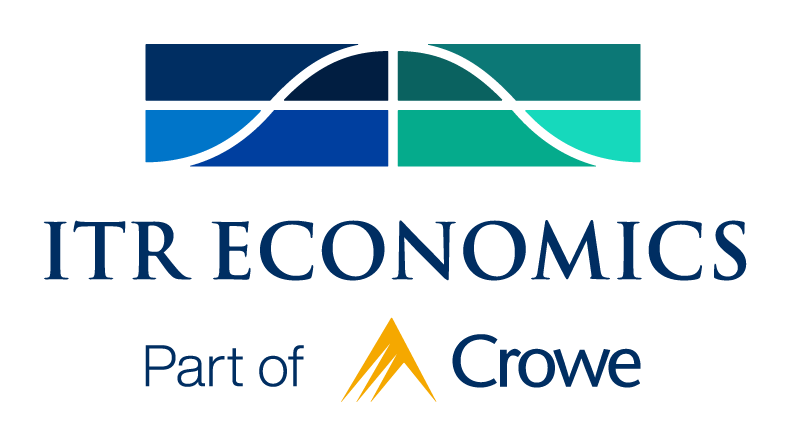September 30, 2024
- Home
- portfolio
- TrendsTalk
- September 30, 2024
B2B SPENDING AND POTENTIAL INTEREST RATE CUT IMPACT
This week on TrendsTalk, ITR Economist Michael Feuz highlights our expectations for business-to-business activity and capital expenditures as 2024 ends and 2025 begins. What sort of impact might the Federal Reserve’s recent interest rate cut have on business spending? Tune in to learn more!

MEET YOUR HOST
Michael Feuz
Michael Feuz is a key member of ITR Economics’ team of expert economists and consultants. Backed by a decade of experience working for technology start-ups, he contributes to the production of client reports, forecast reviews, economic research, and regular client-facing communications.
“Join me on the TrendsTalk podcast to explore the world of economics. Episodes offer insightful discussion and expert interviews. We cover relevant economic concepts in an accessible way. Whether you are a curious layperson or an industry professional, TrendsTalk is your go-to source for thought-provoking analysis and a deeper understanding of the economic forces shaping our world.”
Key Episode Takeaways
- 0:28 – Discussing business-to-business (B2B) activity
- 2:30 – The many factors influencing future B2B activity
- 4:46 – Expectations for Non-Defense Capital Goods New Orders in 2024 and 2025
- 6:35 – The impact of the Federal Reserve’s 50 basis point interest rate cut
The below transcript is a literal translation of the podcast audio that has been machine generated by Notta.
Michael Feuz:
Hey, everyone. Welcome back to another episode of TrendsTalk. Again, I’m Michael Feuz, filling in for Taylor St. Germain just the next few weeks. If you joined us last week, you know, we talked about Onshore and Nearshore. I’m going to kind of tie that in a little bit to this week’s talk.
Recently, in conversations we’ve been having with some of our clients, other folks that we talked to when we’re out on the road, is a little bit of questions around business-to-business activity, hearing that sales are generally down or slow or that customers are delaying orders, holding off, just this mentality of wait and see. There’s a little bit of pessimism as we’re kind of closing out the end of this year. So really, I want to talk about our expectations here at ITR for business-to-business activity as we finish out 2024. And what we expect in 2025 is this rise, how quickly will the rise come back, what to expect in the first half versus the second half.
So when we’re looking at business-to-business activity or capital expenditures, CAPEX, the series I really like to focus on is Non-Defense Capital Goods New Orders, excluding Aircraft, so in parentheses, a little bit of a mouthful. But that’s the best measure of what’s going on in that B2B activity. If we look at Non-Defense Capital Goods New Orders right now, this is data through July. So on a 12-month moving total, that 12 MMT, it came in at $885.2 billion over those past 12 months ending in July. That’s up 0.7% on a 12/12 basis. So that’s generally pretty flat, nearing that zero line, kind of showing that what folks have been saying, a lot of businesses are delaying orders or in that wait and see mentality. The data is certainly corroborating that. And that is very likely primarily driven by… the interest rate environment, the high interest rates. Yes, we just got some cuts. Our initial cut from the Federal Reserve we’ll talk about what that means, but also likely bloated inventories.
Now, our expectations for this Non-Defense Capital Goods New Orders, I really wanna focus on four indicators that help kind of show us where we’re at and a little bit where we’re headed. Those four being one, onshoring, government spending, similarly a little bit touched on that last week, and then Domestic Non-Financial Corporate Profits, and then fourth, Domestic Corporate Cash Holdings.
So the first two briefly touching on onshoring and government spending are both likely contributing to some upside pressure or helping keep this series a little positive. We’re getting that onshoring if you didn’t listen to last week. I certainly encourage you to go back and listen to it, but onshoring is providing a little bit of a boost amid the slowdown and government spending similarly, focusing on a lot of that high tech industrial production, helping pull aggregate demand up a little bit, providing a little near term boost.
If we look at those other two series indicators, the Non-Financial Domestic corporate Profits and the Domestic Corporate Cash Holdings. The corporate profits on a 3.12 basis is slightly up, about 6.4%. It leads business-to-business spending by about nine months. So typically when you see profits rise, business spending will pick up, investment will pick up when it starts to slow. Similarly, eventually you see that slowdown. So that recent rise there is showing us that profitability is up, it’s rising. So companies are profitable. Similarly with corporate cash holdings, it’s remaining at a very healthy level, well above pre-pandemic levels.
So what does this mean? It means that businesses are profitable. They have healthy amounts of cash to invest. So interest rates, not necessarily. This is a way, if you have cash, you don’t have to leverage financing amid a high interest rate environment. So if I’m a sales leader going to my sales reps who maybe are feeling a little down, if sales are being a little slow, if our customers are delaying orders, I’m using this as an encouragement. We know our customers are profitable. We know they have cash on hand. The rallying cry is it’s our moral obligation to relieve them of this cash.
Now use the end of this year, this 2024 period, we expect this Non-Defense Capital Goods New series to be generally flat the next two quarters or so as we round out this year with a little downside bias. It might go a little negative on that 12/12 basis, but take advantages. If you win that million dollars of new business in the next, as we round out this year, that can organically grow into two, three million for the sake of example, in a higher growth environment, which we expect in 2025.
Now, looking at our forecast for Non-Defense Capital Goods New Orders, excluding aircraft, we do expect cyclical rise and growth in 2025. But keep in mind, we anticipate some growth cyclical rise generally on that 12/12 basis, but slower growth, that’s kind of recovery, more recovery-ish, slower growth in that first half of the next year, and then higher rates of growth as we move into the back half of the year. So just keep that in mind as you plan and strategize, probably still a little bit slower in that first half, but be getting ready for that demand to start to return. Evaluate your capacity, needs, your labor constraints. Do we need to make key hires? What training should we be doing right now?
I want to pivot briefly. We got our initial interest rate cut last week from the Federal Reserve, a little bit, I guess, on the surprising side that they went with the 50 basis point cut initially. So some encouragement there that things will pick up. I would anticipate another rate cut or two. ITR was looking and still expecting somewhere between 25 and 100 basis points with that 50 basis point cut. That 100 total basis point seems more likely.
Overall, I wouldn’t expect that immediate jump back into spending. We still have a high interest rate environment, but this is getting the ball rolling, the Federal Reserve slowing down or pulling back on that contractionary monetary policy. But most organizations I would anticipate still a little bit of that wait and see mentality, but good news and a good start of what we anticipate coming in 2025.
Now, next year, as I’ve encouraged you to prepare for it, we’re expecting higher rates of growth. We have a tight labor market that’s keeping upward pressure on wages. We’re getting that disinflation as we’re looking at CPI is down to about 2.8% and we’re getting those interest rate cuts. So higher growth, a more confidence in businesses and consumers with general disinflation into the middle of next year expected and lower interest rates is going to help create and fuel an environment of growth with more confidence. This will help continue to drive demand. drive those new orders and really informs that expectation for those higher rates of growth next year. So it’s important to, while we’re near that business cycle low right now and that B2B activity, to take advantage of this environment, try to capture new business and market share now that will help, that will grow organically and at higher rates in a healthier environment next year and use the slowdown to prepare and set yourselves up for that healthier environment to come in 2025.
So I’ll leave it there for now. Again, I’m Michael Feuz, economist and speaker here at ITR. Looking forward to continue to join you over the next several weeks. Talk to you soon.





